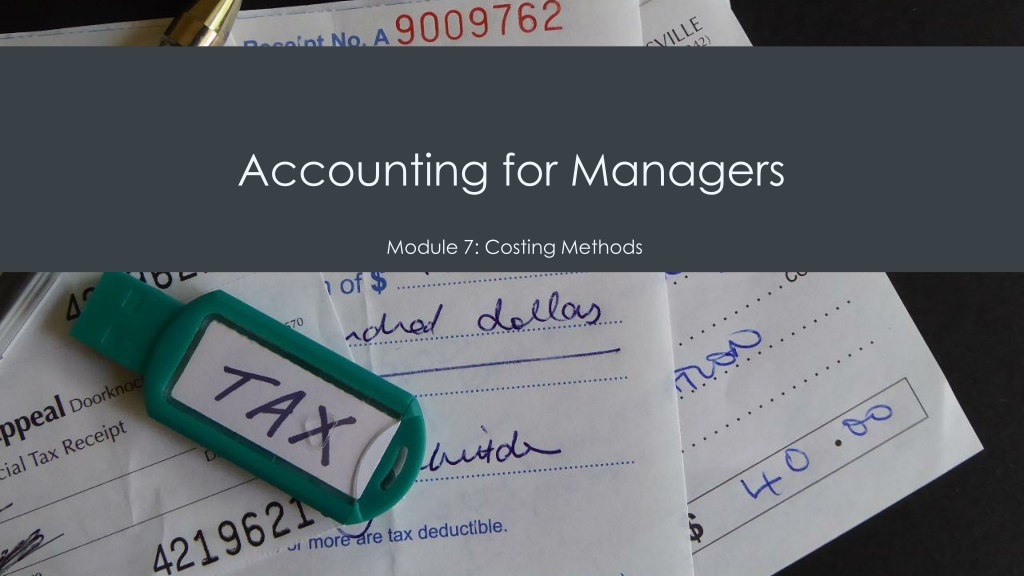
Costing Methods in Accounting for Managers
Explore the concepts of costing methods in accounting, including cost management, direct and indirect costs, job order costing, calculating costs, and process costing. Understand the flow of costs in both job order and process costing systems, along with the differences between the two approaches. Learn how businesses use job order costing to track products and services, and determine overhead costs through predetermined rates.
Download Presentation

Please find below an Image/Link to download the presentation.
The content on the website is provided AS IS for your information and personal use only. It may not be sold, licensed, or shared on other websites without obtaining consent from the author. If you encounter any issues during the download, it is possible that the publisher has removed the file from their server.
You are allowed to download the files provided on this website for personal or commercial use, subject to the condition that they are used lawfully. All files are the property of their respective owners.
The content on the website is provided AS IS for your information and personal use only. It may not be sold, licensed, or shared on other websites without obtaining consent from the author.
E N D
Presentation Transcript
Accounting for Managers Module 7: Costing Methods
Value Chain The value chain is the process of business functions that add value to the customer user of a particular product.
Direct and Indirect Costs Direct costs are those that are directly attributable or traceable to the manufacture of a product or performance of a service, while an indirect cost cannot be directly attributable or traceable to a product or service.
Understanding Job Order Costing Different types of businesses use job order costing Manufacturing companies use the process to track the products they build, while service businesses use a job order costing system to invoice clients
Calculating Costs Overhead costs can be allocated by determining an overhead rate Predetermined overhead rate = estimated total manufacturing cost There are four steps to determining the overhead rate
Recording Job Order Costs Every single time product moves or people work, there will be a journal entry to create. 1. The first purchase is of raw materials 2. Raw materials are requisitioned for use in production 3. Labor costs 4. Manufacturing overhead costs 5. Depreciation, property taxes, and insurance.
Job Order Costing vs Process Costing What is the difference between job order costing and process costing?
Flow of Costs (Process Costing) In process planning we will cost by process Start with the basic inputs: Raw materials Wages Manufacturing overhead Costing is simpler because you only need to do costing for three departments or processes
Equivalent Unit Calculations Equivalent units: Equivalent units = number of partially completed units x percentage completed Two ways to calculate the the equivalent units of production for a department or process: 1. Weighted average 2. FIFO
Cost Reconciliation When using the same data, you will end up with different units of production quantity when using the FIFO and Weighted Average methods. In order to reconcile this difference, work in progress (WIP) costs need to be adjusted accordingly.
Direct and Step-Down Methods (cont.) Direct method: Most commonly used method of allocation ALL of the services from the service department are allocated to the operating departments Allocation can be done employee hours, square footage, etc. Step-Down method: More complicated Takes into account the services that one service department offers another Human resource costs are allocated between custodial and all the operational processes
Activity-Based Costing Activity-based absorption costing assigns all manufacturing overhead costs to products based on the activities performed to make those products. Only look at non-direct costs More complicated than traditional costing but can give you a much better allocation picture
Traditional Costing vs. ABC Traditional: One rate for allocation for the entire business operation Easy to implement; most common ABC: Creates multiple cost pools Complicated and difficult to implement
Quick Review Why should I be aware of the value chain? Managerial accounting ties together all the processes of the value chain Direct vs. Indirect costs What s the most efficient way for my business to calculate it s costs? Direct vs. Step-Down Methods Traditional Costing vs. ABC Which one will help my costs to be most accurate yet also help me stay cost effective?
